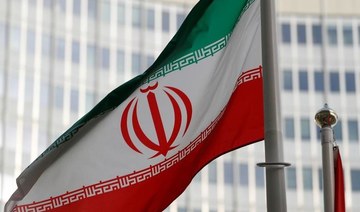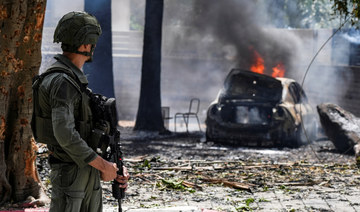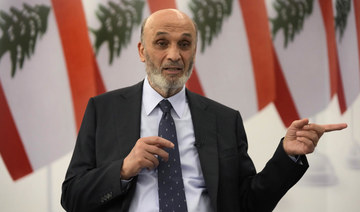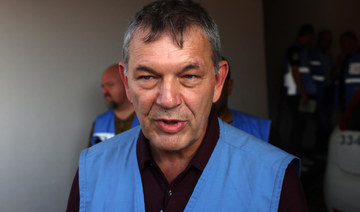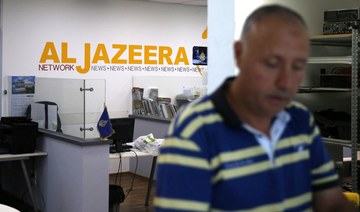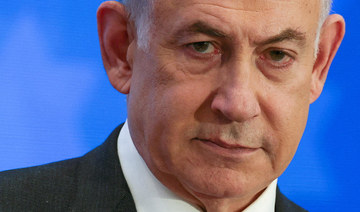DUBAI: Near a peak of the Zagros Mountains in central Iran, workers are building a nuclear facility so deep in the earth that it is likely beyond the range of a last-ditch US weapon designed to destroy such sites, according to experts and satellite imagery analyzed by The Associated Press.
The photos and videos from Planet Labs PBC show Iran has been digging tunnels in the mountain near the Natanz nuclear site, which has come under repeated sabotage attacks amid Tehran’s standoff with the West over its atomic program.
With Iran now producing uranium close to weapons-grade levels after the collapse of its nuclear deal with world powers, the installation complicates the West’s efforts to halt Tehran from potentially developing an atomic bomb as diplomacy over its nuclear program remains stalled.
Completion of such a facility “would be a nightmare scenario that risks igniting a new escalatory spiral,” warned Kelsey Davenport, the director of nonproliferation policy at the Washington-based Arms Control Association. “Given how close Iran is to a bomb, it has very little room to ratchet up its program without tripping US and Israeli red lines. So at this point, any further escalation increases the risk of conflict.”
The construction at the Natanz site comes five years after then-President Donald Trump unilaterally withdrew America from the nuclear accord. Trump argued the deal did not address Tehran’s ballistic missile program, nor its support of militias across the wider Middle East.
But what it did do was strictly limit Iran’s enrichment of uranium to 3.67 percent purity, powerful enough only to power civilian power stations, and keep its stockpile to just some 300 kilograms (660 pounds).
Since the demise of the nuclear accord, Iran has said it is enriching uranium up to 60 percent, though inspectors recently discovered the country had produced uranium particles that were 83.7 percent pure. That is just a short step from reaching the 90 percent threshold of weapons-grade uranium.
As of February, international inspectors estimated Iran’s stockpile was over 10 times what it was under the Obama-era deal, with enough enriched uranium to allow Tehran to make “several” nuclear bombs, according to the head of the International Atomic Energy Agency.
President Joe Biden and Israel’s prime minister have said they won’t allow Iran to build a nuclear weapon. “We believe diplomacy is the best way to achieve that goal, but the president has also been clear that we have not removed any option from the table,” the White House said in a statement to the AP.
The Islamic Republic denies it is seeking nuclear weapons, though officials in Tehran now openly discuss their ability to pursue one.
Iran’s mission to the United Nations, in response to questions from the AP regarding the construction, said that “Iran’s peaceful nuclear activities are transparent and under the International Atomic Energy Agency safeguards.” However, Iran has been limiting access for international inspectors for years.
Iran says the new construction will replace an above-ground centrifuge manufacturing center at Natanz struck by an explosion and fire in July 2020. Tehran blamed the incident on Israel, long suspected of running sabotage campaigns against its program.
Tehran has not acknowledged any other plans for the facility, though it would have to declare the site to the IAEA if they planned to introduce uranium into it. The Vienna-based IAEA did not respond to questions about the new underground facility.
The new project is being constructed next to Natanz, about 225 kilometers (140 miles) south of Tehran. Natanz has been a point of international concern since its existence became known two decades ago.
Protected by anti-aircraft batteries, fencing and Iran’s paramilitary Revolutionary Guard, the facility sprawls across 2.7 square kilometers (1 square mile) in the country’s arid Central Plateau.
Satellite photos taken in April by Planet Labs PBC and analyzed by the AP show Iran burrowing into the Kūh-e Kolang Gaz Lā, or “Pickaxe Mountain,” which is just beyond Natanz’s southern fencing.
A different set of images analyzed by the James Martin Center for Nonproliferation Studies reveals that four entrances have been dug into the mountainside, two to the east and another two to the west. Each is 6 meters (20 feet) wide and 8 meters (26 feet) tall.
The scale of the work can be measured in large dirt mounds, two to the west and one to the east. Based on the size of the spoil piles and other satellite data, experts at the center told AP that Iran is likely building a facility at a depth of between 80 meters (260 feet) and 100 meters (328 feet). The center’s analysis, which it provided exclusively to AP, is the first to estimate the tunnel system’s depth based on satellite imagery.
The Institute for Science and International Security, a Washington-based nonprofit long focused on Iran’s nuclear program, suggested last year the tunnels could go even deeper.
Experts say the size of the construction project indicates Iran likely would be able to use the underground facility to enrich uranium as well — not just to build centrifuges. Those tube-shaped centrifuges, arranged in large cascades of dozens of machines, rapidly spin uranium gas to enrich it. Additional cascades spinning would allow Iran to quickly enrich uranium under the mountain’s protection.
“So the depth of the facility is a concern because it would be much harder for us. It would be much harder to destroy using conventional weapons, such as like a typical bunker buster bomb,” said Steven De La Fuente, a research associate at the center who led the analysis of the tunnel work.
The new Natanz facility is likely to be even deeper underground than Iran’s Fordo facility, another enrichment site that was exposed in 2009 by US and other world leaders. That facility sparked fears in the West that Iran was hardening its program from airstrikes.
Such underground facilities led the US to create the GBU-57 bomb, which can plow through at least 60 meters (200 feet) of earth before detonating, according to the American military. US officials reportedly have discussed using two such bombs in succession to ensure a site is destroyed. It is not clear that such a one-two punch would damage a facility as deep as the one at Natanz.
With such bombs potentially off the table, the US and its allies are left with fewer options to target the site. If diplomacy fails, sabotage attacks may resume.
Already, Natanz has been targeted by the Stuxnet virus, believed to be an Israeli and American creation, which destroyed Iranian centrifuges. Israel also is believed to have killed scientists involved in the program, struck facilities with bomb-carrying drones and launched other attacks. Israel’s government declined to comment.
Experts say such disruptive actions may push Tehran even closer to the bomb — and put its program even deeper into the mountain where airstrikes, further sabotage and spies may not be able to reach it.
“Sabotage may roll back Iran’s nuclear program in the short-term, but it is not a viable, long-term strategy for guarding against a nuclear-armed Iran,” said Davenport, the nonproliferation expert. “Driving Iran’s nuclear program further underground increases the proliferation risk.”
Iran nuclear site deep underground challenges West as talks on reviving atomic deal have stalled
https://arab.news/jknzv
Iran nuclear site deep underground challenges West as talks on reviving atomic deal have stalled

- New footage shows Iran has been digging tunnels in the mountain near the Natanz nuclear site
- The installation complicates the West’s efforts to halt Tehran from potentially developing an atomic bomb
UN atomic watchdog chief due in Iran as concern grows over nuclear activity
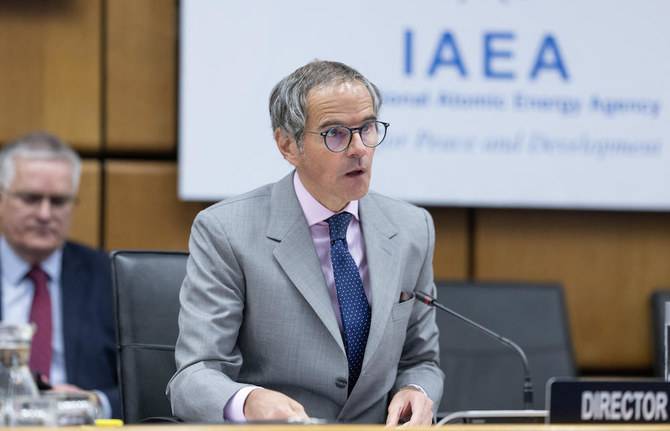
- Visit comes at a time of heightened regional tensions and with IAEA criticizing Iran for lack of cooperation on inspections and other outstanding issues
TEHRAN: UN atomic watchdog chief Rafael Grossi is set to arrive in Iran on Monday, where he is expected to speak at a conference and meet officials for talks on Tehran’s nuclear program.
The visit comes at a time of heightened regional tensions and with the International Atomic Energy Agency (IAEA) criticizing Iran for lack of cooperation on inspections and other outstanding issues.
Grossi, head of the IAEA, is expected to deliver a speech at Iran’s first International Conference on Nuclear Science and Technology.
The three-day event, which starts on Monday, is being held in Isfahan province, home to the Natanz uranium enrichment plant and where strikes attributed to Israel hit last month.
The IAEA and Iranian officials reported “no damage” to nuclear facilities after the reported attack on Isfahan, widely seen as Israel’s response to Iran’s first-ever direct attack on its arch foe days earlier, which itself was a retaliation for a deadly strike on Tehran’s Damascus consulate.
During his visit, Grossi is expected to meet with Iranian officials including the Islamic republic’s nuclear chief Mohammad Eslami.
On Wednesday Eslami, head of the Atomic Energy Organization of Iran, said he was “sure that these negotiations will further help clear ambiguities, and we will be able to strengthen our relations with the agency.”
Iran in recent years has deactivated IAEA monitoring devices at nuclear facilities and barred inspectors, according to the UN agency.
Grossi last visited Iran in March 2023 and met with top officials including President Ebrahim Raisi.
Iran has suspended its compliance with caps on nuclear activities set by a landmark 2015 deal with major powers after the United States in 2018 unilaterally withdrew from the agreement and reimposed sweeping sanctions.
Tensions between Iran and the IAEA have repeatedly flared since the deal fell apart, while EU-mediated efforts have so far failed both to bring Washington back on board and to get Tehran to again comply with the terms of the accord.
Last year, Iran slowed down the pace of its uranium enrichment, which was seen as a goodwill gesture while informal talks began with the United States.
But the Vienna-based UN nuclear agency said Iran accelerated the production of 60-percent enriched uranium in late 2023.
Enrichment levels of around 90 percent are required for military use.
Tehran has consistently denied any ambition to develop nuclear weapons, insisting that its atomic activities were entirely peaceful.
In February, the IAEA said in a confidential report seen by AFP that Iran’s estimated stockpile of enriched uranium had reached 27 times the limit set out in the 2015 accord.
On Sunday, the Iranian official news agency IRNA said Grossi’s visit provides “an opportunity for the two sides to share their concerns,” especially with regard to the IAEA’s inspectors.
Iran in September withdrew the accreditation of several inspectors, a move described at the time by the UN agency as “extreme and unjustified.”
Tehran, however, said its decision was a consequence of “political abuses” by the United States, France, Germany and Britain.
Eslami said the IAEA has “more than 130 inspectors” working in Iran, insisting Tehran remains committed to cooperating with the nuclear watchdog.
Lebanon’s Hezbollah says fired dozens of rockets at Israeli base

- The Israeli army said its warplanes “struck a Hezbollah military structure... deep inside Lebanon,”
The Iran-backed Hezbollah group said it fired “dozens of Katyusha rockets” at an Israeli base in the occupied Golan Heights on Monday in retaliation for a strike in Lebanon’s east.
Earlier, Lebanese official media said three people had been wounded in an Israeli strike early Monday in the country’s east, with the Israeli army saying it had struck a Hezbollah “military compound.”
Hezbollah fighters launched “dozens of Katyusha rockets” targeting “the headquarters of the Golan Division... at Nafah base,” the group said in a statement, saying it was “in response to the enemy’s attack targeting the Bekaa region.”
Israel and Lebanon’s Hezbollah have exchanged regular cross-border fire since Palestinian militant group Hamas’s unprecedented October 7 attack on southern Israel sparked war in the Gaza Strip.
In recent weeks Hamas-ally Hezbollah has stepped up its attacks on northern Israel, and the Israeli military has struck deeper into Lebanese territory.
“Enemy warplanes launched a strike at around 1:30 am this morning on a factory in Sifri, wounding three civilians and destroying the building,” Lebanon’s official National News Agency said.
Sifri is located in Lebanon’s Bekaa Valley, near the city of Baalbek, around 80 kilometers from the Israel-Lebanon frontier.
The Israeli army said its warplanes “struck a Hezbollah military structure... deep inside Lebanon,” referring to the location as “Safri.”
Last month, a building in Sifri was targeted in an Israeli raid, according to a source close to Hezbollah, while the Israeli army said it had targeted Hezbollah sites in Lebanon’s east.
East Lebanon’s Baalbek area is a Hezbollah stronghold and has been repeatedly struck by Israel in recent weeks.
On Sunday official media in Lebanon said an Israeli strike on a southern village killed four family members, with Hezbollah announcing retaliatory fire by dozens of rockets toward Kiryat Shmona in northern Israel.
The intensifying exchanges have stoked fears of all-out conflict between Israel and Hezbollah, which went to war in 2006.
In Lebanon, at least 390 people have been killed in nearly seven months of cross-border violence, mostly militants but also more than 70 civilians, according to an AFP tally.
Israel says 11 soldiers and nine civilians have been killed on its side of the border.
Tens of thousands of people have been displaced on both sides.
Israel attacks Rafah after Hamas claims responsibility for deadly rocket attack
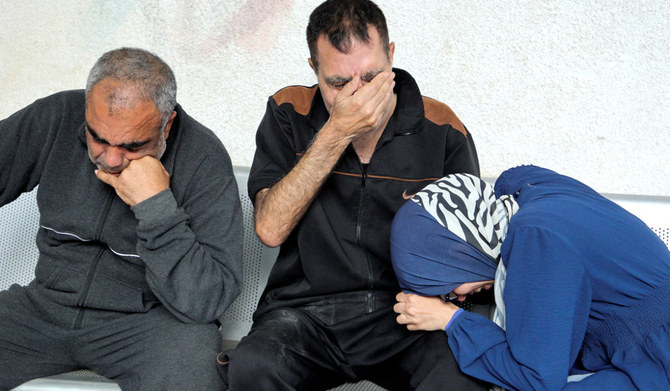
- Hamas claims attack on Kerem Shalom crossing into Gaza that Israel says killed three soldiers
- Sunday's attack on the crossing came as hopes dimmed for ceasefire talks underway in Cairo
CAIRO: Three Israeli soldiers were killed in a rocket attack claimed by Hamas armed wing, near the southern Gaza Strip city of Rafah, where Palestinian health officials said at least 19 people were killed by Israeli fire on Sunday.
Hamas's armed wing claimed responsibility on Sunday for an attack on the Kerem Shalom crossing into Gaza that Israel said killed three of its soldiers.
Israel's military said 10 projectiles were launched from Rafah in southern Gaza towards the area of the crossing, which it said was now closed to aid trucks going into the coastal enclave. Other crossings remained open.
Hamas' armed wing said it fired rockets at an Israeli army base by the crossing, but did not confirm where it fired them from. Hamas media quoted a source close to the group as saying the commercial crossing was not the target.
More than a million Palestinians are sheltering in Rafah, near the border with Egypt.
Shortly after the Hamas attack, an Israeli airstrike hit a house in Rafah killing three people and wounding several others, Palestinian medics said.
The Israeli military confirmed the counter-strike, saying it struck the launcher from which the Hamas projectiles were fired, as well as a nearby "military structure".
"The launches carried out by Hamas adjacent to the Rafah Crossing ... are a clear example of the terrorist organisation's systematic exploitation of humanitarian facilities and spaces, and their continued use of the Gazan civilian population as human shields," it said.
Hamas denies it uses civilians as human shields.
Just before midnight, an Israeli air strike killed nine Palestinians, including a baby, in another house in Rafah, Gaza health officials said. They said the new strike increased the death toll on Sunday to at least 19 people.
Israel has vowed to enter the southern Gaza city and flush out Hamas forces there, but has faced mounting pressure to hold fire as the operation could derail fragile humanitarian efforts in Gaza and endanger many more lives.
Sunday's attack on the crossing came as hopes dimmed for ceasefire talks under way in Cairo.
The war began after Hamas stunned Israel with a cross-border raid on Oct. 7 in which 1,200 people were killed and 252 hostages taken, according to Israeli tallies.
More than 34,600 Palestinians have been killed, 29 of them in the past 24 hours, and more than 77,000 have been wounded in Israel's assault, according to Gaza's health ministry.
Israel begins evacuating part of Rafah, Hamas decries ‘dangerous escalation’

- Witnesses say the areas in and around Rafah to which Israel wants to move people are already crowded and there is almost no room for more tents to be added
RAFAH, Gaza Strip: Israel told Palestinians to evacuate parts of Rafah on Monday in what appeared to be preparation for a long-threatened assault on Hamas holdouts in the southern Gaza Strip city where more than a million war-displaced people have been sheltering.
Instructed by Arabic text messages, telephone calls, and flyers to move to what the Israeli military called an “expanded humanitarian zone” 20km away, some Palestinian families lumbered out under chilly spring rain, witnesses said.
A senior official of Hamas, the militant Palestinian group that governs Gaza, said the evacuation order was a “dangerous escalation that will have consequences.”
“The US administration, alongside the occupation, bears responsibility for this terrorism,” the official, Sami Abu Zuhri, said, referring to Israel’s alliance with Washington.
Israel’s military said it had begun encouraging residents of Rafah to evacuate in a “limited scope” operation. It gave no specific reasons, nor did it say if any offensive action might follow.
“It has been raining heavily and we don’t know where to go. I have been worried that this day may come, I have now to see where I can take my family,” one refugee in Rafah, Abu Raed, said via a chat app.
Witnesses said the areas in and around Rafah to which Israel wants to move people are already crowded and there is almost no room for more tents to be added.
An Israeli offensive in Rafah “would be devastating for 1.4 million people” sheltering there, the UN agency for Palestinian refugees, UNRWA, said on X, adding it would keep a presence in Rafah as long as possible to provide aid.
Seven months into its war against Hamas, Israel has been threatening to launch incursions in Rafah, which it says harbors thousands of Hamas fighters and potentially dozens of hostages. Victory is impossible without taking Rafah, it says.
The prospect of a high-casualty operation worries Western powers and neighboring Egypt, which is trying to mediate a new round of truce talks between Israel and Hamas under which the Palestinian Islamist group might free some hostages.
RIFT
The Rafah plan has opened an unusually public rift between Israel and Washington. Speaking to his UScounterpart, Israeli Defense Minister Yoav Gallant linked Monday’s operation to the deadlock in indirect diplomacy, which he blamed on Hamas.
“During their discussion, Gallant discussed the efforts undertaken to achieve the release of hostages and indicated that at this stage, Hamas refuses the frameworks at hand,” the Israeli Defense Ministry said in a statement.
“Gallant emphasized that military action is required, including in the area of Rafah, at the lack of an alternative,” it added
An Israeli broadcaster, Army Radio, said evacuations were focused on a few peripheral districts of Rafah, from which evacuees would be directed to tent cities in nearby Khan Younis and Al Muwassi.
Many residents in Rafah said they had received telephone calls to evacuate their homes in the targeted area, in line with the army announcement.
In an overnight aerial attack on Rafah, Israeli planes hit 10 houses, killing 20 people and wounding several, medical officials said.
Three Israeli soldiers were killed on Sunday in a Hamas rocket attack near Rafah, at the Kerem Shalom crossing into Gaza, while Palestinian health officials said at least 19 people were killed by Israeli fire.
Sunday’s crossing attack came as hopes dimmed for ceasefire talks in Cairo, with Hamas reiterating its demand for an end to the war in exchange for the freeing of hostages, and Israeli Prime Minister Benjamin Netanyahu flatly ruling that out.
“Our just war in Gaza continues with the exact same goals: the release of all hostages and the defeat of Hamas,” Israeli Foreign Minister Israel Katz said on Monday on X, blaming the Palestinian group for the lack of progress in the Cairo talks.
The war began after Hamas stunned Israel with a cross-border raid on Oct. 7 in which 1,200 people were killed and 252 hostages taken, according to Israeli tallies.
More than 34,600 Palestinians have been killed, 29 of them in the past 24 hours, and more than 77,000 have been wounded in Israel’s assault, according to Gaza’s health ministry.
On Sunday, a top UN official accused Israel of continuing to deny the United Nations humanitarian access in the Gaza Strip, where the UN food chief warned a “full-blown famine” has taken hold in the north of the enclave of 2.3 million people.
While not a formal declaration, World Food Programme Executive Director Cindy McCain said, in an NBC News interview broadcast on Sunday, that based on the “horror” on the ground: “There is famine, full-blown famine, in the north, and it’s moving its way south.”
Netanyahu uses Holocaust ceremony to brush off international pressure against Gaza offensive

- The ceremony ushered in Israel’s first Holocaust remembrance day since the Oct. 7 Hamas attack that sparked the war, imbuing the already somber day with additional meaning
JERUSALEM: Israeli Prime Minister Benjamin Netanyahu on Sunday rejected international pressure to halt the war in Gaza in a fiery speech marking the country’s annual Holocaust memorial day, declaring: “If Israel is forced to stand alone, Israel will stand alone.”
The message, delivered in a setting that typically avoids politics, was aimed at the growing chorus of world leaders who have criticized the heavy toll caused by Israel’s military offensive against Hamas militants and have urged the sides to agree to a ceasefire.
Netanyahu has said he is open to a deal that would pause nearly seven months of fighting and bring home hostages held by Hamas. But he also says he remains committed to an invasion of the southern Gaza city of Rafah, despite widespread international opposition because of the more than 1 million civilians huddled there.
“I say to the leaders of the world: No amount of pressure, no decision by any international forum will stop Israel from defending itself,” he said, speaking in English. “Never again is now.”
Yom Hashoah, the day Israel observes as a memorial for the 6 million Jews killed by Nazi Germany and its allies in the Holocaust, is one of the most solemn dates on the country’s calendar. Speeches at the ceremony generally avoid politics, though Netanyahu in recent years has used the occasion to lash out at Israel’s archenemy Iran.
The ceremony ushered in Israel’s first Holocaust remembrance day since the Oct. 7 Hamas attack that sparked the war, imbuing the already somber day with additional meaning.
Hamas militants killed some 1,200 people in the attack, making it the deadliest violence against Jews since the Holocaust.
Israel responded with an air and ground offensive in Gaza, where the death toll has soared to more than 34,500 people, according to local health officials, and about 80 percent of Gaza’s 2.3 million people are displaced. The death and destruction has prompted South Africa to file a genocide case against Israel in the UN’s world court. Israel strongly rejects the charges.
On Sunday, Netanyahu attacked those accusing Israel of carrying out a genocide against the Palestinians, claiming that Israel was doing everything possible to ensure the entry of humanitarian aid to the Gaza Strip.
The 24-hour memorial period began after sundown on Sunday with a ceremony at Yad Vashem, Israel’s national Holocaust memorial, in Jerusalem.
There are approximately 245,000 living Holocaust survivors around the world, according to the Claims Conference, an organization that negotiates for material compensation for Holocaust survivors. Approximately half of the survivors live in Israel.
On Sunday, Tel Aviv University and the Anti-Defamation League released an annual Antisemitism Worldwide Report for 2023, which found a sharp increase in antisemitic attacks globally.
It said the number of antisemitic incidents in the United States doubled, from 3,697 in 2022 to 7,523 in 2023.
While most of these incidents occurred after the war erupted in October, the number of antisemitic incidents, which include vandalism, harassment, assault, and bomb threats, from January to September was already significantly higher than the previous year.
The report found an average of three bomb threats per day at synagogues and Jewish institutions in the US, more than 10 times the number in 2022.
Other countries tracked similar rises in antisemitic incidents. In France, the number nearly quadrupled, from 436 in 2022 to 1,676 in 2023, while it more than doubled in the United Kingdom and Canada.
“In the aftermath of the October 7 war crimes committed by Hamas, the world has seen the worst wave of antisemitic incidents since the end of the Second World War,” the report stated.
Netanyahu also compared the recent wave of protests on American campuses to German universities in the 1930s, in the runup to the Holocaust. He condemned the “explosion of a volcano of antisemitism spitting out boiling lava of lies against us around the world.”
Nearly 2,500 students have been arrested in a wave of protests at US college campuses, while there have been smaller protests in other countries, including France. Protesters reject antisemitism accusations and say they are criticizing Israel. Campuses and the federal government are struggling to define exactly where political speech crosses into antisemitism.



